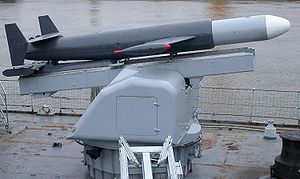Malafon
Malafon
Standoff Anti-submarine missile
Malafon (MArine LAtécoère FONds) was a French ship-launched anti-submarine missile system. Developed in the 1950s and 1960s, the weapon was intended to take advantage of the greater detection ranges possible with towed sonar arrays. The missile entered service in 1966 and was manufactured by Groupe Latécoère
This article has multiple issues. Please help improve it or discuss these issues on the talk page. (Learn how and when to remove these template messages)
|
The weapon is essentially a glider-delivered version of the L4 torpedo. The launcher is a circular mount, which allows the weapon to be rotated to the correct bearing, then fired at a fixed elevation of +15°. Two solid booster rockets accelerate it to 830 km/h (520 mph) within 4 seconds before falling away. The unpowered glider continues at an altitude of 100 metres (330 ft), altering course in mid-flight under radio control of the launch platform. Effective range was 13 km (8.1 mi). As it reaches the target, the glider drops the torpedo, which splashes into the sea and commences a circular search pattern. The range of the Malafon meant that it was expected to hit the water within 800 metres (2,600 ft) of the submarine's location. The L4 torpedo had a speed of 30 kn (56 km/h; 35 mph) over a range of 5 km (3.1 mi).
The Malafon was a large weapon, with each missile weighing 1,330 kg (2,930 lb). As a result, it was only employed on larger vessels. It was typically used for medium- and long-range submarine targets, though it could have been used against surface ships.
The system was never used at war. It was declared obsolete in 1997. It was replaced by Westland Lynx helicopters using Mark 46 torpedoes.
